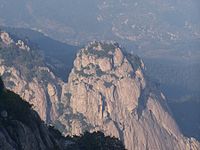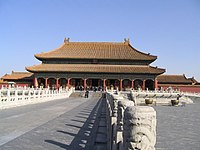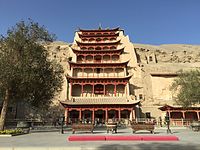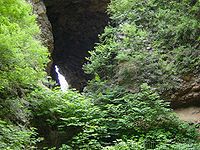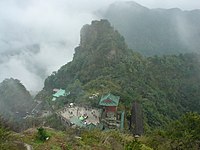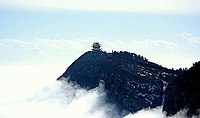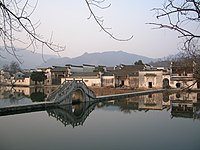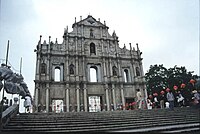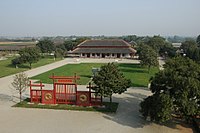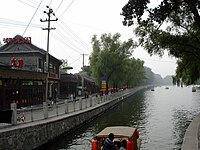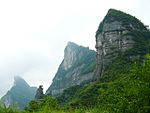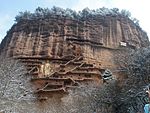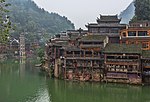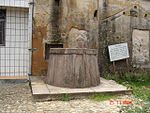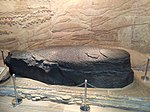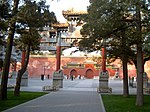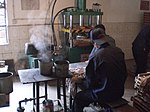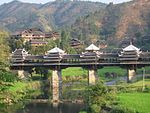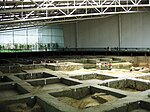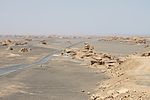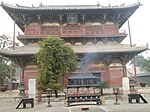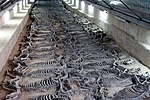World Heritage in China
The world heritage in China (as of 2019) includes 55 UNESCO world heritage sites , including 37 world cultural heritage sites, 14 world natural heritage sites and 4 mixed cultural and natural heritage sites. The People's Republic of China ratified the World Heritage Convention in 1985, and the first six World Heritage sites were added to the World Heritage List in 1987. The last World Heritage site to date was registered in 2019.
World heritage sites
The following table lists the UNESCO World Heritage Sites in China in chronological order according to the year of their inclusion on the World Heritage List (K - cultural heritage, N - natural heritage, K / N - mixed, (R) - on the Red List of World Heritage in Danger ).
![]() Map with all coordinates of World Heritage Sites: OSM
Map with all coordinates of World Heritage Sites: OSM
| image | designation | year | Type | Ref. | description |
|---|---|---|---|---|---|
|
Mountain region Tai Shan ( location ) |
1987 | K / N | 437 | The Tài Shān in Shandong Province is one of the five sacred mountains of Daoism . | |
|
Great Wall ( location ) |
1987 | K | 438 | in 17 sub-government cities, provinces and autonomous regions | |
| Imperial Palaces of the Ming and Qing Dynasties in Beijing and Shenyang | 1987 | K | 439 | In 1987 the Forbidden City , the Imperial Palace of the Ming Dynasty and the Qing Dynasty in Beijing , was added to the World Heritage List, and in 2004 the World Heritage Site was expanded to include the Imperial Palace of the Qing Dynasty in Shenyang ( Liaoning Province ) | |
| Mogao Caves | 1987 | K | 440 | ( Gansu Province ) | |
| Tomb of the first emperor of China, Qin Shihuangdi | 1987 | K | 441 | The tomb for the first Chinese emperor Qin Shihuangdi (near Xi'an in Shaanxi Province ) was built in 221 BC. And the emperor became in 210 BC. Buried in it. The mausoleum is one of the world's largest grave structures and is best known for its large soldiers, the so-called "Terracotta Army". | |
| Peking man's site in Zhoukoudian | 1987 | K | 449 | in a cave in Zhoukoudian (in Beijing ), the first bone of 1926 were Peking Man found | |
| Huang Shan mountain landscape | 1990 | K / N | 547 | ( Anhui Province ) | |
| Jiuzhaigou Valley Landscape Park | 1992 | N | 637 | Mountain landscape in Sichuan Province with a multitude of lakes and waterfalls, in which numerous species of birds and rare mammals can be found. | |
| Lime sinter terrace landscape Huanglong | 1992 | N | 638 | ( Sichuan Province ) | |
| Wulingyuan Landscape Park | 1992 | N | 640 | ( Hunan Province ) | |
| Summer residence and temples near Chengde | 1994 | K | 703 | includes the Summer Palace and the eight outer temples near Chengde ( Hebei Province ) | |
| Confucius Temple, Cemetery and Residence of the Kong Family in Qufu | 1994 | K | 704 | ( Shandong Province ) | |
| Taoist shrines in the mountains of Wudang | 1994 | K | 705 | Daoist shrines in the mountains of Wudang Shan ( Hubei Province ) | |
| Historical ensemble Potala Palace in Lhasa | 1994 | K | 707 | includes Potala Palace , Jokhang and Norbulingka in Lhasa ( Tibet Autonomous Region ) | |
| Lushan National Park | 1996 | K | 778 | ( Jiangxi Province ) | |
| Mountain landscape of Emei Shan and Leshan Big Buddha | 1996 | K / N | 779 | includes the holy Mount Emei Shan and the Leshan Great Buddha ( Sichuan Province ) | |
| Lijiang old town | 1997 | K | 811 | ( Yunnan Province ) | |
| Old Town of Ping Yao | 1997 | K | 812 | ( Shanxi Province ) | |
| Suzhou Classical Gardens | 1997 | K | 813 | The cultural heritage originally consisted of four gardens in Suzhou City in east China's Jiangsu Province . In 2000 five more gardens were included in this serial world heritage. | |
| Imperial Garden (so-called Summer Palace) near Beijing | 1998 | K | 880 | ||
| Temple of Heaven with an imperial sacrificial altar in Beijing | 1998 | K | 881 | ||
| Wuyi Mountains | 1999 | K / N | 911 | ||
| Rock art by Also | 1999 | K | 912 | ||
| Qincheng Mountain and Dujiangyan Irrigation System | 2000 | K | 1001 | includes the Qingcheng Shan and Dujiangyan irrigation systems ( Sichuan Province ) | |
| Xidi and Hongcun villages | 2000 | K | 1002 | includes the traditional villages of Xidi and Hongcun in Anhui Province | |
| Longmen Grottoes | 2000 | K | 1003 | (near Luoyang in Henan Province ) | |
| Imperial tombs of the Ming and Qing dynasties | 2000 | K | 1004 | ( Hubei , Hebei , Jiangsu , Liaoning and Beijing City Provinces , expanded in 2003 and 2004) | |
| Yungang grottoes | 2001 | K | 1039 | Wolkengrat Grottoes in Nanjiao , City Datong in the province of Shanxi | |
| Protection zones in the National Park of the "Three Parallel Rivers" in Yunnan | 2003 | N | 1083 | Nature reserve in which the rivers Yangtze , Mekong and Saluen run almost parallel to one another, separated from one another by high mountain ranges. | |
| Capitals and tombs of the ancient kingdom of Koguryo | 2004 | K | 1135 | includes 40 of the tombs on the Donggou River as well as three capital cities of the Koguryŏ Kingdom before they were moved to Pyongyang : Wunu Shancheng , Guonei Cheng and Wandu Shancheng ( Jilin and Liaoning provinces ).
More in North Korea lying tombs was under the name of Koguryo tombs in the World Heritage in North Korea was added (Ref 1091 ). |
|
| Historic Center of Macau | 2005 | K | 1110 | ||
| Yin Xu | 2006 | K | 1114 | Remains of the capital Yin of the later Shang dynasty near Anyang , Henan Province | |
| Panda nature reserve in Sichuan | 2006 | N | 1213 | The panda bear sanctuary in Sichuan Province includes 7 nature reserves, including a. the Wolong nature reserve , and 9 nature parks | |
| Dialolou towers and villages in Kaiping | 2007 | K | 1112 | Diaolou are fortified residential towers. They are particularly common in Kaiping City in Jiangmen , Guangdong Province . | |
| Karst landscapes in southern China | 2007, 2014 | N | 1248 | Comprises a total of 12 sites in seven locations that were added to the World Heritage List in two phases in 2007 and 2014. The sites are located in the provinces of Yunnan , Guizhou , Guangxi and the government-direct city of Chongqing . | |
| Tulou loam buildings in Fujian | 2008 | K | 1113 | Tulou are large houses with usually three to five floors and up to several meters thick outer walls made of clay. They can accommodate up to 800 people. This house shape is traditionally used by the Hakka in Fujian Province . | |
| Sanqingshan National Park | 2008 | N | 1292 | Granite landscape of the Sanqing Shan Mountains in Jiangxi Province | |
| Wutai Shan | 2009 | K | 1279 | The Wutai Shan in Shanxi Province is one of the four sacred mountains of Buddhism in China . | |
| Historic sites of Dengfeng in the "center of heaven and earth" | 2010 | K | 1305 | includes the Zhongyue Temple on the holy Song Shan Mountain and 7 other historical sites in Dengfeng City , Henan Province , etc. a. the Gaocheng Observatory | |
| Danxia landscapes | 2010 | N | 1335 | includes the following individual locations:
|
|
| West Lake cultural landscape near Hangzhou | 2011 | K | 1334 | Cultural landscape in the vicinity of the West Lake near Hangzhou in the Zhejiang Province | |
| Chengjiang Fossil Site | 2012 | N | 1388 | Chengjiang Fauna Community Fossil Site in Chengjiang County, Yunnan Province | |
| Xanadu - former capital of the Mongol ruler Kublai Khan | 2012 | K | 1389 | Site of the Xanadu or Shangdu summer residence of Kublai Khan in Inner Mongolia | |
| Hani Cultural Landscape: Honghe Rice Terraces in Yunnan Province | 2013 | K | 1111 | in the Honghe Autonomous District of the Hani and Yi in Yunnan | |
| Tian Shan Mountains in Xinjiang | 2013 | N | 1414 | includes the Tomur nature reserve with the Jengish Chokusu (Tomur) in the Aksu administrative region , the Kalajun provincial park and the Kuerdening nature reserve in the Kazakh Autonomous District Ili , the Bayinbuluke Nature Reserve in the Mongolian Autonomous District Bayingolin and the Tian-Shan-Tianchi- National park with the mountain Bogda and the mountain lake Tianchi and the Bogda nature reserve in the autonomous district Changji der Hui . | |
| Silk Roads: the road network of the Chang'an-Tianshan Corridor | 2014 | K | 1442 | Sites on the branch of the Silk Road that ran from the ancient Chinese city of Chang'an through the Tianshan Mountains .
The transnational world heritage site includes 22 sites in China. 11 other sites are in Kazakhstan and Kyrgyzstan . |
|
| Kaiserkanal (Great Canal) | 2014 | K | 1443 | Fragments between Tianjin and Hangzhou | |
| Tusi sites | 2015 | K | 1474 | Places of rule according to the Tusi system, includes the ruined cities of Laosicheng and Tangya and the mountain fortress Hailongtun | |
|
Rock paintings of the cultural landscape at the Hua Shan and the Zuo Jiang River ( location ) |
2016 | K | 1508 | The rock carvings are located on steep rock faces along the south-western border of China in a karst, river and plateau landscape. They go back to the 5th century BC. BC to the 2nd century AD and show the life and rituals of the Luoyue people. The ceremonies shown are interpreted as depictions of the Dong Son culture that was previously prevalent in northern Vietnam and southern China . The rock paintings are in Ningming , Longzhou and Jiangzhou . | |
|
Shennongjia - forest area in the Chinese province of Hubei ( location ) |
2016 | N | 1509 | includes the two forest areas of Shennongding and Laojunshan in the Shennongjia forest area in Hubei Province | |
|
Qinghai Hoh Xil ( location ) |
2017 | N | 1540 | largest and highest plateau in the world | |
|
Gulangyu: a historical international settlement ( location ) |
2017 | K | 1541 | Island that has been settled by many colonial powers over the course of its history, all of which left their architectural mark.
now part of the Siming Township of the prefecture [Xiamen] in Fujian Province . |
|
|
Fanjingshan ( location ) |
2018 | N | 1559 | Fanjingshan ( 梵净山 ) is a nature reserve in the central Chinese province of Guizhou around the mountain of the same name, 2570 meters high. The park is characterized on the one hand by great scenic beauty and on the other hand by great biodiversity. In addition, Fanjingshan is considered a sacred place of Chinese Buddhism . | |
|
Liangzhu City Archaeological Ruins ( Location ) |
2019 | K | 1592 | The city of Liangzhu was a late Neolithic regional state that existed between 3300 and 2300 BC. Existed in the delta of the Yangtze . Archaeological remains include ceramic and jade artifacts and a water storage system. See also Liangzhu culture . | |
|
Migratory bird sanctuaries along the coast of the Yellow Sea - Gulf of Bohai (Phase I) ( Location ) |
2019 | N | 1606 | Covers parts of a tidal and tidal system that is considered to be the largest in the world. The intertidal zones of the Yellow Sea and the Gulf of Bohai are important gathering places for many migratory bird species that move along the East Asian-Australasian migratory route. |
Tentative list
The sites that are intended for nomination for inclusion in the World Heritage List are entered in the tentative list .
Current World Heritage candidates
As of 2019, 60 sites are entered in the tentative list of China, the last entry was made in 2019. The following table lists the sites in chronological order according to the year they were included in the tentative list.
![]() Map with all coordinates of current World Heritage candidates: OSM
Map with all coordinates of current World Heritage candidates: OSM
| image | designation | year | Type | Ref. | description |
|---|---|---|---|---|---|
| Dongzhai Mangrove Nature Reserve | 1996 | N | 105 | ||
| China Alligator Nature Reserve | 1996 | N | 106 | ||
| Poyang nature reserve | 1996 | N | 107 | ||
| River landscape of the Lijiang near Guilin | 1996 | N | 108 | ||
| Yangtze River Gorges | 2001 | K / N | 1623 | ||
|
Jinfoshan ( location ) |
2001 | K / N | 1624 | Although still on the tentative list, it has been a World Heritage Site since 2014 as part of the Karst Landscapes World Heritage complex in southern China | |
| Xiaozhai-Tiankeng and Difeng | 2001 | N | 1625 | The Xiaozhai-Tiankeng ("Xiaozhai Sky Pit") is a karst pit about 666 meters deep and 522 to 622 meters in diameter in the Xiaozhai municipality and the largest karst funnel in the world.
A large underground river flows under the Xiaozhai-Tiankeng. The river water gushes out of a karst fissure ( Difeng ) that is about 37 kilometers long and over 900 meters deep. The narrowest part of this column measures only two meters, the widest about 60 to 70 meters. It is the deepest and longest karst fissure known worldwide. |
|
| Hua Shan | 2001 | K / N | 1625 | ||
| Yandangshan | 2001 | K / N | 1627 | The Yandangshan is a rocky mountain range in the Chinese coastal province of Zhejiang. It was formed about 120 to 100 million years ago through volcanic activity due to tectonic processes. Over the millions of years, the effect of erosion has created an extremely diverse landscape, which in the past centuries has also stimulated many writers and travelers to examine the landscape. | |
| Nanxi (river, Zhejiang) | 2001 | N | 1629 | ||
| Maijishan Grottoes | 2001 | K / N | 1631 | ||
| Wudalianchi | 2001 | N | 1632 | ||
| Haitan Archipelago | 2001 | N | 1633 | ||
| Dali Chanshan and Erhai Lake | 2001 | N | 1634 | ||
| Alcohol production sites in China | 2008 | K | 5320 | Five production facilities in Xushui , Jinxian , Chengdu , Luzhou and Mianzhu | |
| Ancient houses in Shanxi and Shaanxi | 2008 | K | 5322 | Sites in Dingcun and Dangjiacun | |
| City walls of the Ming and Qing dynasties | 2008 | K | 5324 | Xingcheng , Nanking , Jingzhou and Xi'an City Walls | |
| Shouxi Lake and Yangzhou Historic City | 2008 | K | 5327 | ||
| Historic riverside towns south of the Yangtze River | 2008 | K | 5328 | Zhouzhuang , Luzhi , Wuzhen and Xitang in Zhejiang and Jiangsu Provinces | |
| Fenghuang Historical City | 2008 | K | 5337 | Fenghuang (Xiangxi) ( Hunan Province ) | |
| Sites of the Nan Yue Empire | 2008 | K | 5338 | includes three archaeological sites: the palace, the tomb of the Nan Yue ruler and the site of the wooden aquatic animal | |
| Ancient hydrological inscriptions from Baiheliang | 2008 | K | 5341 | ||
| Miao villages in southeast Guizhou | 2008 | K | 5344 | The villages are in Leishan , Taijiang , Jianhe and Congjiang counties . | |
| Qanat fountain in Turpan | 2008 | K | 5347 | in Turpan ( Xinjiang Uyghur Autonomous Region ) | |
| Prince Lujian's tombs | 2008 | K | 5351 | in Xinxiang City ( Henan Province ), Expansion of the World Heritage Site Imperial Tombs of the Ming and Qing Dynasties | |
| Five sacred mountains of Taoism | 2008 | K | 5353 | Extension of Tai Shan : Heng Shan (Hunan) , Hua Shan , Song Shan and Heng Shan (Shanxi) | |
| Euphrates poplar forests of the Taklamakan desert | 2010 | K | 5532 | ||
| Nature reserves in the Altai Mountains | 2010 | N | 5533 | The World Heritage candidate comprises two nature reserves: 1. Kanas nature reserve ( 48 ° 58 ′ N , 87 ° 18 ′ E ), and 2. Headwaters of the two rivers Ergis and Ulungur ( 47 ° 30 ′ N , 89 ° 50 ′ E ) |
|
| Karakoram Pamirs | 2010 | N | 5535 | Karakoram and Pamir Mountains in the Xinjiang Autonomous Region | |
|
Central axis of Beijing ( location ) |
2013 | K | 5803 | Central axis of Beijing (with Beihai Park ) | |
| Liao Dynasty wooden buildings | 2013 | K | 5803 | Wood Pagoda in Yingxian , main hall of Fengguo Monastery in Yixian | |
| Hongshan Culture Archaeological Sites | 2013 | K | 5804 | The archaeological sites of Niuheliang , Hongshanhou and Weijiawopu | |
| Ancient china distilleries in China | 2013 | K | 5806 | The nominated sites include: Yue Kilns on Shanglin Lake ( location ), Dayao ( location ), Xikou ( location ), Jincun ( location ) and Yangqiaotou ( location ). | |
|
Sanfang Qixiang ( location ) |
2013 | K | 5808 | Historic city area in Fuzhou ( Fujian Province ). | |
|
Old tea plantations on Jingmai Mountain in Pu'er ( Lage ) |
2013 | K | 5810 | More than 1000 years old tea plantations on Mount Jingmai (Jingmaishan) in Pu'er in the southern border region of Yunnan | |
|
Western Xia Imperial Tombs ( Location ) |
2013 | K | 5811 | ||
| Dong villages | 2013 | K | 5813 | Comprises a total of 22 villages of the Dong ethnic group in Guizhou Province. | |
|
Lingqu Canal ( location ) |
2013 | K | 5814 | The Lingqu Canal in the northeast of Guizhou Province connects the Xiang River with the Li River and thus the catchment area of the Yangtze River with that of the Pearl River . | |
| Diaolou Buildings and Tibetan and Qiang Villages | 2013 | K | 5815 | The Diaolou buildings and villages of the Tibetan and Qiang ethnic groups are located in the high mountain valleys of the eastern Qinghai-Tibet Plateau and comprise 225 Diaolou buildings and 15 villages, which are spread over the following counties: Barkam , Jinchuan , Wenchuan , Li , and Mao in the Ngawa and Qiang Autonomous Districts , and in Kangding , Danba , and Daofu in the Garzê Tibetan Autonomous District in Sichuan Province on the upper reaches of the Dadu He and Min Rivers in the Hengduan Mountains . | |
| Shu State Archaeological Sites | 2013 | K | 5816 | Archaeological Sites of Ancient Shu State: Site in Jinsha and common graves with boat-shaped coffins in Chengdu , Sichuan Province; Sanxingdui site in Guanghan , Sichuan Province, 29C BC-5C.BC | |
| Yardangs in Xinjiang | 2015 | N | 5989 | ||
| Yardangs of Dunhuang | 2015 | N | 5990 | ||
|
Tianzhushan ( location ) |
2015 | K / N | 5992 | The Tianzhushan is a mountain range in the area of the independent city of Qianshan of the independent city of Anqing in the Chinese province of Anhui . It is located in the center of a nature reserve. The region is of importance due to its rare geological peculiarities, as well as from a cultural and historical perspective. | |

|
Jinggangshan - North Wuyishan (Extension of Wuyi Mountains ) | 2015 | K / N | ||
|
Shu Dao ( location ) |
2015 | K / N | 5994 | ||
|
Tulin-Guge ( location ) |
2015 | K / N | 5995 | ||
|
Historic Monuments and Sites of Ancient Quanzhou (Zayton) ( Location ) |
2016 | K | 6073 | ||

|
Chinese Section of the Silk Road : Land Routes in Henan , Shaanxi , Gansu , Qinghai Provinces and Ningxia and Xinjiang Autonomous Areas ; Sea routes in Ningbo City , Zhejiang Province and Quanzhou City , Fujian Province - from the Western Han Dynasty to the Qing Dynasty . | 2016/2008 | K | The Silk Road has been nominated twice | |
| Guancenshan - Luyashan | 2017 | N | Contains two clusters: Luyashan with Guanqinshan and Tianchi - protected area for Larix principis-rupprechtii | ||
|
Landscape of Hulun-Buir and the birthplace of an old minority ( Lage ) |
2017 | K / N | 6185 | Qinghai Lake National Park and Qinghai Lake National Nature Reserve | |
|
Qinghai Lake ( location ) |
2017 | N | 6186 | Qinghai Lake National Park and Qinghai Lake National Nature Reserve | |
|
Historic landscapes of sacred mountains and lakes ( location ) |
2017 | K / N | 6187 | Include u. a. the peaks Gang Rinpoche (6638 m) and Naimona'nyi (7694 m), as well as the holy lake Manasarovar and the ghost lake Lhanag-tso in Tibet. | |
|
The vertical vegetation and volcanic landscape in the Changbai Mountains ( location ) |
2017 | N | 6190 | ||
| Taihangshan | 2017 | K / N | 6188 | includes 4 areas: Hebei, Huangya Cave, Wangwushan and Yuntaishan | |
|
Jingdezhen Imperial Kiln Sites ( Location ) |
2017 | K | 6265 | ||
| Badain Jaran Desert - towers of sand and lakes | 2019 | N | 6379 | ||
|
Triassic fossil sites in Guizhou ( location ) |
2019 | N | 6381 | ||
| Picturesque landscape of Huangguoshu | 2019 | K / N | 6380 | includes Huangguoshu Waterfall , Dishuitan Waterfall, and historic villages, a temple and an irrigation system. The Huangguoshu waterfall was already on the tentative list in 1992. |
Former World Heritage candidates
These sites were previously on the tentative list, but were withdrawn or rejected by UNESCO. Sites that are included in other entries on the tentative list or that are part of world heritage sites are not taken into account here.
![]() Map with all coordinates of former World Heritage candidates: OSM
Map with all coordinates of former World Heritage candidates: OSM
| image | designation | year | Type | Ref. | description |
|---|---|---|---|---|---|
| Jixian - Conservation area of the Middle and Late Proterozoic Era | 1987-1987 | N | Evidence of the Proterozoic Era in Jixian County
Was rejected in 1987. |
||
|
Anji Bridge ( location ) |
1996-2009 | K | 95 | also called Zhaozhou Bridge | |
| Xi'an Forest of Steles | 1996-2009 | K | 115 | ||
|
Kaiyuan Temple Pagoda in Dingzhou ( location ) |
1996-2009 | K | 119 | ||
| Dule temple | 1996-2009 | K | 120 | ||
| Old Beijing Observatory | 1996-2009 | K | 128 | ||
| Lugou bridge | 1996-2009 | K | 129 | also called the Marco Polo Bridge | |
| Antique Tonglüshan copper mine | 1996-2009 | K | 130 | ||
| Yongle Palace | 1996-2009 | K | 134 | ||
| Old town of Tongli | 1998-2008 | K | 9940 | ||
| Old Venetian city complex in the southern Yangtze - Nanxun | 1998-2008 | K | 9941 | ||
|
Putuo Shan Recreation Area ( location ) |
2001-2009 | K / N | 1628 | ||
| Tangyue, Likeng and Wangkou | 2008-2013 | K | 5349 | Planned expansion of the Old Villages in South Anhui (Ref. 1002 ), which was registered in 2000 with the villages of Xidi and Hongcun, to include the villages of Tangyue , Likeng and Wangkou | |
| Courtyard houses of businessmen in Shanxi | 2008-2013 | K | 5321 | Business people's homes with courtyard in Shanxi Province | |
| Former copper mines in Tongling | 2008-2013 | K | 5333 | former copper mining sites in the town of Tongling | |
| Temple of Confucius on the Nishan | 2008-2013 | K | 5350 | The Nishan, a hill in Shandong , is believed to be the birthplace of Confucius
Planned expansion of the world heritage site Confucius Temple, cemetery and residence of the Kong family in Qufu (Ref. # ) |
|
| Pagoda, library caves and stone tablets of sutra in Yunju Temple | 2008-2013 | K | |||
| Site of the capital of the Qi State and mausoleum of the King of the Qi State in Linzi | 2008-2013 | K | Linzi was the capital of the ancient Qi state | ||
| Tusi sites | 2013-2015 | K | 5809 | Three of the four proposals were added to the World Heritage List in 2015 (Ref. 1474 ). The Tusi sites of Rongmei (Rongmei tusi yizhi) in Hefeng County are not registered . |
Web links
- China on the UNESCO World Heritage Center website.
- UNESCO China Photos Image gallery of the UNESCO World Heritage Sites in China
- World cultural heritage in China at www.china-reisefuehrer.com
Individual evidence
- ↑ China. In: whc.unesco.org. UNESCO World Heritage Center, accessed March 3, 2018 .
- ↑ German names according to the World Heritage List. In: www.unesco.de. German UNESCO Commission, accessed on March 17, 2018 .
- ^ Tentative list of China. In: whc.unesco.org. UNESCO World Heritage Center, accessed March 3, 2018 .
- ^ Former Tentative Sites of China. In: World Heritage Site. Retrieved March 3, 2018 .


